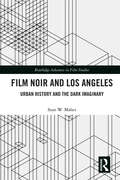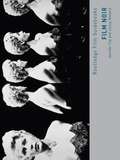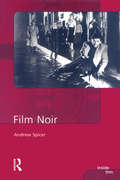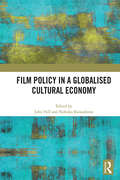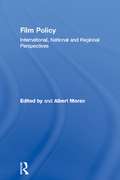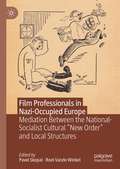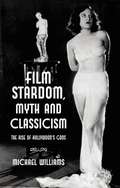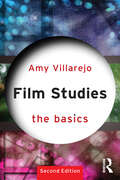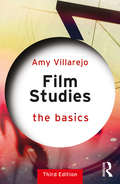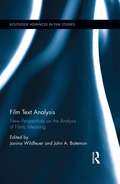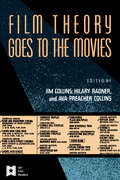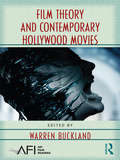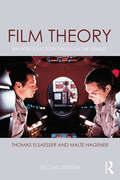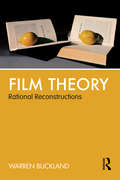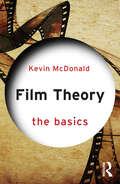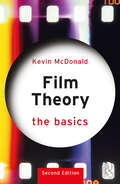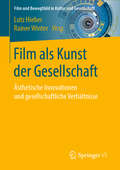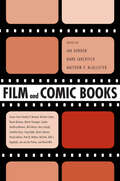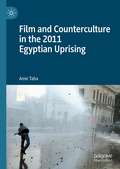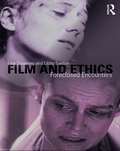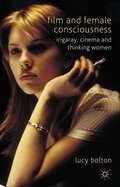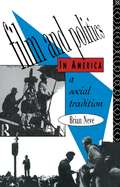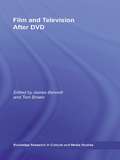- Table View
- List View
Film Noir and Los Angeles: Urban History and the Dark Imaginary (Routledge Advances in Film Studies)
by Sean W. MaherThis book combines film studies with urban theory in a spatial exploration of twentieth century Los Angeles. Configured through the dark lens of noir, the author examines an alternate urban history of Los Angeles forged by the fictional modes of detective fiction, film noir and neo noir. Dark portrayals of the city are analyzed in Raymond Chandler’s crime fiction through to key films like Double Indemnity (1944) and The End of Violence (1997). By employing these fictional elements as the basis for historicising the city’s unrivalled urban form, the analysis demonstrates an innovative approach to urban historiography. Revealing some of the earliest tendencies of postmodern expression in Hollywood cinema, this book will be of great relevance to students and researchers working in the fields of film, literature, cultural and urban studies. It will also be of interest to scholars researching histories of Los Angeles and the American noir imagination.
Film Noir: Hard-boiled Modernity and the Cultures of Globalization (Routledge Film Guidebooks)
by Justus Nieland Jennifer FayThe term "film noir" still conjures images of a uniquely American malaise: hard-boiled detectives, fatal women, and the shadowy hells of urban life. But from its beginnings, film noir has been an international phenomenon, and its stylistic icons have migrated across the complex geo-political terrain of world cinema. This book traces film noir’s emergent connection to European cinema, its movement within a cosmopolitan culture of literary and cinematic translation, and its postwar consolidation in the US, Europe, Asia, the Middle East, and Latin America. The authors examine how film noir crosses national boundaries, speaks to diverse international audiences, and dramatizes local crimes and the crises of local spaces in the face of global phenomena like world-wide depression, war, political occupation, economic and cultural modernization, decolonization, and migration. This fresh study of film noir and global culture also discusses film noir’s heterogeneous style and revises important scholarly debates about this perpetually alluring genre.
Film Noir: On Classic Film Noir (Inside Film)
by Andrew SpicerFilm Noir is an overview of an often celebrated, but also contested, body of films. It discusses film noir as a cultural phenomenon whose history is more extensive and diverse than American black and white crime thrillers of the forties. An extended Background Chapter situates film noir within its cultural context, describing its origin in German Expressionism, French Poetic Realism and in developments within American genres, the gangster/crime thriller, horror and the Gothic romance and its possible relationship to changes in American society. Five chapters are devoted to ‘classic’ film noir (1940-59): chapters explore its contexts of production and reception, its visual style, and its narrative patterns and themes chapters on character types and star performances elucidate noir’s complex construction of gender with its weak, ambivalent males and predatory femmes fatales and also provide a detailed analysis of three noir auteurs, - Anthony Mann, Robert Siodmak and Fritz Lang Three chapters investigate ‘neo-noir’ and British film noir: chapters trace the complex evolution of ‘neo-noir’ in American cinema, from the modernist critiques of Night Moves and Taxi Driver, to the postmodern hybridity of contemporary noir including Seven, Pulp Fiction and Memento the final chapter surveys the development of British film noir, a significant and virtually unknown cinema, stretching from the thirties to Mike Hodges’ Croupier Films discussed include both little known examples and seminal works such as Double Indemnity, Scarlet Street, Kiss Me Deadly and Touch of Evil. A final section provides a guide to further reading, an extensive bibliography and a list of over 500 films referred to in the text. Lucidly written, Film Noir is an accessible, informative and stimulating introduction that will have a broad appeal to undergraduates, cinéastes, film teachers and researchers.
Film Policy in a Globalised Cultural Economy
by John Hill Nobuko KawashimaThe past two decades have witnessed major changes in film industries worldwide in response to both economic globalisation and technological developments. The dominant position of Hollywood movies in the global film market has remained largely uncontested, but Hollywood itself has become increasingly international in its operations whilst ‘regional’ screen industries such as those in East Asia and in the Indian subcontinent have (re-)emerged and developed new forms of collaboration. The advent of digital technologies has also transformed the content of films and the ways in which they are made and consumed. Such changes, in turn, have posed new economic and cultural challenges for policy-makers around the world and led to a degree of rethinking of how film policy objectives are to be conceived, defined and implemented. This collection brings together a range of international scholars from the USA, Europe and Asia to consider how film policy has responded to the various economic, technological and political shifts shaping the global film industry; and to identify the many tensions between global and local, economic and cultural, and public and private policy objectives that have been the result of these changes. This book was originally published as a special issue of the International Journal of Cultural Policy.
Film Policy: International, National and Regional Perspectives (Culture: Policy and Politics)
by Albert MoranFilm Policy is the first comprehensive overview of the workings of the international film industry. The authors examine film cultures and film policy across the world, explaining why Hollywood cinema dominates the global film market, and the effects of the rise of television and video on the international industry. In a series of case studies drawn from North America, Europe, Latin America, Asia and Australia, the authors explore the relationship between Hollywood cinema product and national film cultures, and trace the development of international and national film policies, looking at issues of financing, regulation, protectionism and censorship.
Film Professionals in Nazi-Occupied Europe: Mediation Between the National-Socialist Cultural “New Order” and Local Structures
by Roel Vande Winkel Pavel SkopalThis book analyses the film industries and cinema cultures of Nazi-occupied countries (1939-1945) from the point of view of individuals: local captains of industry, cinema managers, those working for film studios and officials authorized to navigate film policy. The book considers these people from a historical perspective, taking into account their career before the occupation and, where relevant, pays attention to their post-war lives. The perspectives of these historical agents” contributes to an understanding of how top-down orders and haphazard signals from the occupying administration were moulded, adjusted and distorted in the process of their translation and implementation. This edited collection offers a more dynamic and less deterministic approach to research on the international expansion of Third-Reich cinema in World War Two; an approach that strives to balance the role of individual agency with the structural determinants. The case studies presented in this book cover the territories of Belgium, Czechoslovakia, France, the Netherlands, Norway, Poland and the Soviet Union.
Film Stardom, Myth and Classicism
by Michael WilliamsSince the golden era of silent movies, stars have been described as screen gods, goddesses and idols. This is the story of how Olympus moved to Hollywood to divinise stars as Apollos and Venuses for the modern age, and defined a model of stardom that is still with us today.
Film Studies: A Global Approach (The Basics)
by Amy VillarejoFilm Studies: The Basics is a compelling guide to the study of cinema in all its forms. This second edition has been thoroughly revised and updated to take account of recent scholarship, the latest developments in the industry and the explosive impact of new technologies. Core topics covered include: The history, technology and art of cinema Theories of stardom, genre and film-making The movie industry from Hollywood to Bollywood Who does what on a film set Complete with film stills, end-of-chapter summaries and a substantial glossary, Film Studies: The Basics is the ideal introduction to those new to the study of cinema.
Film Studies: A Global Introduction
by Amy Villarejo Kay Dickinson Glyn Davis Lisa PattiFilm Studies: A Global Introduction reroutes film studies from its Euro-American focus and canon in order to introduce students to a medium that has always been global but has become differently and insistently so in the digital age. Glyn Davis, Kay Dickinson, Lisa Patti and Amy Villarejo’s approach encourages readers to think about film holistically by looking beyond the textual analysis of key films. In contrast, it engages with other vital areas, such as financing, labour, marketing, distribution, exhibition, preservation, and politics, reflecting contemporary aspects of cinema production and consumption worldwide. Key features of the book include: clear definitions of the key terms at the foundation of film studies coverage of the work of key thinkers, explained in their social and historical context a broad range of relevant case studies that reflect the book’s approach to global cinema, from Italian "white telephone" films to Mexican wrestling films innovative and flexible exercises to help readers enhance their understanding of the histories, theories, and examples introduced in each chapter an extensive Interlude introducing readers to formal analysis through the careful explication and application of key terms a detailed discussion of strategies for writing about cinema Films Studies: A Global Introduction will appeal to students studying film today and aspiring to work in the industry, as well as those eager to understand the world of images and screens in which we all live.
Film Studies: The Basics (The Basics)
by Amy VillarejoA comprehensive overview of how to study film, this updated third edition provides concise and provocative summaries for approaching the language of film analysis, ways of thinking about film history, and approaches and methods for studying cinema, from national cinemas to genre to stardom and beyond. The new edition tracks the changes in film production and exhibition by situating the study of film within contemporary digital media cultures and structures, such as social media and streaming platforms. Without forsaking its emphasis on the study of film, the third edition updates its examples and provides fresh insight into today’s image culture. Film Studies: The Basics provides beginning students in film studies, as well as lifelong film buffs, with the tools to pursue film analysis, film history, and further inquiries into the medium.
Film Text Analysis: New Perspectives on the Analysis of Filmic Meaning (Routledge Advances in Film Studies)
by Janina Wildfeuer John A. BatemanThis book examines film as a multimodal text and an audiovisual synthesis, bringing together current work within the fields of narratology, philosophy, multimodal analysis, sound as well as cultural studies in order to cover a wide range of international academic interest. The book provides new insights into current work and turns the discussion towards recent research questions and analyses, representing and constituting in each contribution new work in the discipline of film text analysis. With the help of various example analyses, all showing the methodological applicability of the discussed issues, the collection provides novel ways of considering film as one of the most complex and at the same time broadly comprehensible texts.
Film Theory Goes to the Movies: Cultural Analysis of Contemporary Film (AFI Film Readers)
by Jim Collins Hilary Radner Ava Preacher CollinsFilm Theory Goes to the Movies fills the gap in film theory literature which has failed to analyze high-grossing blockbusters. The contributors in this volume, however, discuss such popular films as The Silence of the Lambs, Dances With Wolves, Terminator II, Pretty Woman, Truth or Dare, Mystery Train, and Jungle Fever.They employ a variety of critical approaches, from industry analysis to reception study, to close readings informed by feminist, deconstructive and postmodernist theory, as well as recent developments in African American and gay and lesbian criticism. An important introduction to contemporary Hollywood, this anthology will be of interest to those involved in the fields of film theory, literary theory, popular culture, and women's studies.
Film Theory and Contemporary Hollywood Movies (AFI Film Readers)
by Warren BucklandFilm theory no longer gets top billing or plays a starring role in film studies today, as critics proclaim that theory is dead and we are living in a post-theory moment. While theory may be out of the limelight, it remains an essential key to understanding the full complexity of cinema, one that should not be so easily discounted or discarded. In this volume, contributors explore recent popular movies through the lens of film theory, beginning with industrial-economic analysis before moving into a predominately aesthetic and interpretive framework. The Hollywood films discussed cover a wide range from 300 to Fifty First Dates, from Brokeback Mountain to Lord of the Rings, from Spider-Man 3 to Fahrenheit 9/11, from Saw to Raiders of the Lost Ark, and much more. Individual essays consider such topics as the rules that govern new blockbuster franchises, the ‘posthumanist realism’ of digital cinema, video game adaptations, increasingly restricted stylistic norms, the spatial stories of social networks like YouTube, the mainstreaming of queer culture, and the cognitive paradox behind enjoyable viewing of traumatic events onscreen. With its cast of international film scholars, Film Theory and Contemporary Hollywood Movies demonstrates the remarkable contributions theory can offer to film studies and moviegoers alike.
Film Theory: An Introduction through the Senses
by Thomas Elsaesser Malte HagenerWhat is the relationship between cinema and spectator? That is the central question for film theory, and renowned film scholars Thomas Elsaesser and Malte Hagener use this question to guide students through all of the major film theories - from the classical period to today - in this insightful, engaging book. Every kind of cinema (and film theory) imagines an ideal spectator, and then imagines a certain relationship between the mind and body of that spectator and the screen. Using seven distinctive configurations of spectator and screen that move progressively from 'exterior' to 'interior' relationships, the authors retrace the most important stages of film theory from 1945 to the present, from neo-realist and modernist theories to psychoanalytic, 'apparatus', phenomenological and cognitivist theories.
Film Theory: Rational Reconstructions
by Warren BucklandIn Film Theory: Rational Reconstructions, Warren Buckland asks a series of questions about how film theory gets written in the first place: How does it select its objects of study and its methods of inquiry? How does it make discoveries and explain filmic phenomena? And, How does it formulate and solve theoretical problems? He asks these questions of film theory through a rational reconstruction and a classical commentary. Both frameworks clarify and reformulate vague and inexact expressions, redefine obscure concepts, and examine the underlying logic of film theory arguments. This not only subjects film theory to rigorous examination; it also teaches students how to write theory, by enabling them to question and critically interrogate the logic of previous film theory arguments. The book consists of nine chapters that closely examine a series of canonical film books and essays in great detail, by Peter Wollen, Laura Mulvey, Thomas Elsaesser, Stephen Heath, and Slavoj Žižek, among others.
Film Theory: The Basics (The Basics)
by Kevin McDonaldFilm Theory: The Basics provides an accessible introduction to the key theorists, concepts, and debates that have shaped the study of moving images. It examines film theory from its emergence in the early twentieth century to its study in the present day, and explores why film has drawn special attention as a medium, as a form of representation, and as a focal point in the rise of modern visual culture. The book emphasizes how film theory has developed as a historically contingent discourse, one that has evolved and changed in conjunction with different social, political, and intellectual factors. To explore this fully, the book is broken down into the following distinct sections: Theory Before Theory, 1915-1960 French Theory, 1949-1968 Screen Theory, 1969-1996 Post-Theory, 1996-2015 Complete with questions for discussion and a glossary of both key terms and key theorists, Film Theory: The Basics is an invaluable resource for those new to film studies and for anyone else interested in the history and significance of critical thinking in relation to the moving image.
Film Theory: The Basics (The Basics)
by Kevin McDonaldFully updated and expanded throughout, this second edition of Film Theory: The Basics provides an accessible introduction to the key theorists, concepts, and debates that have shaped the study of moving images. The book examines film theory from its emergence in the early twentieth century to its study in the present day, and explores why film has drawn special attention as a medium, as a form of representation, and as a focal point in the rise of modern visual culture. It also emphasizes how film theory has developed as a historically contingent discourse, one that has evolved and changed in conjunction with different social, political, and intellectual factors. This second edition offers a detailed account of new theoretical directions at the forefront of film studies in the twenty-first century, and draws additional attention to how theory engages with today’s most pressing questions about digital technologies, the environment, and racial justice. Complete with questions for discussion and a glossary of both key terms and key theorists, this book in an invaluable resource for those new to film theory and for anyone else interested in the history and significance of critical thinking in relation to the moving image.
Film als Kunst der Gesellschaft: Ästhetische Innovationen und gesellschaftliche Verhältnisse (Film und Bewegtbild in Kultur und Gesellschaft)
by Lutz Hieber Rainer WinterDer Band beschäftigt sich mit dem Kunstbegriff im Hinblick auf Film, wobei es sowohl um ästhetische Theorie als auch um konkrete Werke geht. Das Spektrum umfasst Spielfilme und Dokumentarfilme. Dabei liegt der Schwerpunkt auf den ästhetischen Innovationen des Mediums im Laufe seiner Geschichte und in der Gegenwart. Die Entwicklung visueller Ideen wird auf den historischen und gesellschaftlichen Kontext ihrer Entstehung und Rezeption bezogen. In den Blick geraten Filmautoren, Filmkünstler und Filmbewegungen, die nicht nur im Independent-Film, sondern auch im Mainstream zu finden sind.
Film and Comic Books
by Ian Gordon, Mark Jancovich and Matthew P. McAllisterContributions by Timothy P. Barnard, Michael Cohen, Rayna Denison, Martin Flanagan, Sophie Geoffroy-Menoux, Mel Gibson, Kerry Gough, Jonathan Gray, Craig Hight, Derek Johnson, Pascal Lefevre, Paul M. Malone, Neil Rae, Aldo J. Regalado, Jan van der Putten, and David Wilt In Film and Comic Books contributors analyze the problems of adapting one medium to another; the translation of comics aesthetics into film; audience expectations, reception, and reaction to comic book-based films; and the adaptation of films into comics. A wide range of comic/film adaptations are explored, including superheroes (Spider-Man), comic strips (Dick Tracy), realist and autobiographical comics (American Splendor; Ghost World), and photo-montage comics (Mexico's El Santo). Essayists discuss films beginning with the 1978 Superman. That success led filmmakers to adapt a multitude of comic books for the screen including Marvel's Uncanny X-Men, the Amazing Spider-Man, Blade, and the Incredible Hulk as well as alternative graphic novels such as From Hell, V for Vendetta, and Road to Perdition. Essayists also discuss recent works from Mexico, France, Germany, and Malaysia.
Film and Counterculture in the 2011 Egyptian Uprising
by Amir TahaThis book examines how film articulates countercultural flows in the context of the Egyptian Revolution. The book interrogates the gap between radical politics and radical aesthetics by analyzing counterculture as a form, drawing upon Egyptian films produced between 2010 and 2016. The work offers a definition of counterculture which liberates the term from its Western frame and establishes a theoretical concept of counterculture which is more globally redolent. The book opens a door for further research of the Arab Uprising, arguing for a new and topical model of rebellion and struggle, and sheds light on the interaction between cinema and the street as well as between cultural narratives and politics in the context of the 2011 Egyptian uprising. What is counterculture in the twenty-first century? What role does cinema play in this new notion of counterculture?
Film and Ethics: Foreclosed Encounters
by Lisa Downing Libby SaxtonFilm & Ethics considers a range of films and texts of film criticism alongside disparate philosophical discourses of ethics by Levinas, Derrida, Foucault, Lacanian psychoanalysts and postmodern theorists.
Film and Female Consciousness
by Lucy BoltonFilm and Female Consciousness analyses three contemporary films that offer complex and original representations of women's thoughtfulness and individuality: In the Cut (2003), Lost in Translation (2003) and Morvern Callar (2002). Lucy Bolton compares these recent works with well-known and influential films that offer more familiar treatments of female subjectivity: Klute (1971), The Seven Year Itch (1955) and Marnie (1964). Considering each of the older, celebrated films alongside the recent, unconventional works illustrates how contemporary filmmaking techniques and critical practices can work together to create provocative depictions of on-screen female consciousness. Drawing on the philosophy of Luce Irigaray in relation to women's cultivation of self-knowledge, this book examines female characters as they go through processes of transition or transformation. Bolton's approach demonstrates how the encounter between Irigaray and cinema can yield a fuller understanding of the fundamental relationship between film and philosophy. Through meticulous theoretical positioning, and close textual analysis, Bolton shows how cinema can create works of philosophy that investigate questions of personal identity, sexuality and relationships with others. Furthermore, the book explores the implications of this approach for filmmakers and spectators, and suggests Irigarayan models of authorship and spectatorship that reinvigorate the notion of women's cinema.
Film and Place in an Intercultural Perspective: India-Europe Film Connections
by Krzysztof Stachowiak Hania Janta Jani Kozina Therese Sunngren-GranlundThe book offers an interdisciplinary overview of the film and place relationship from an intercultural perspective. It explores the complex domain of place and space in cinema and the film industry's role in establishing cultural connections and economic cooperation between India and Europe. With contributions from leading international scholars, various case studies scrutinise European and Indian contexts, exploring both the established and emerging locations. The book extends the dominantly Britain-oriented focus on India’s cinema presence in Europe to European countries such as Italy, Switzerland, Poland, Slovenia, Finland, and Sweden, where the Indian film industry progressively expands its presence. The chapters of this book look at Indian film production in Europe as a cultural bridge between India and Europe, fostering mutual understanding of the culture and society of the two regions. This interdisciplinary book will be of interest to researchers in film studies, cultural anthropology, cultural geography, tourism, economics, sociology, and cultural studies. It will also be interest to practitioners working in local authorities, destination management, tourism, and creative business, all of whom see the value of film production in attracting visitors, investment, and creating new networks with local economic actors. The book offers much-needed data and tools to translate their professional goals and potentials into effective regional strategies and activities.
Film and Politics in America: A Social Tradition (Studies In Film, Television And The Media Ser.)
by Brian NeveIn A Social Cinema: Film-making and Politics in America, Brian Neve presents a study of the social and political nature of American film by concentrating on a generation of writers from the thirties who directed films in Hollywood in the 1940's. He discusses how they negotiated their roles in relation to the studio system, itself undergoing change, and to what extent their experience in the political and theatre movements of thirties New York was to be reflected in their later films.Focusing in particular on Orson Welles, Elia Kazan, Jules Dassin, Abraham Polonsky, Nicholas Ray, Robert Rossen and Joseph Losey, Neve relates the work of these writers and directors to the broader industrial, bureaucratic, social and political developments of the period 1935-1970. With special emphasis on the post-war decade, bringing together archive and secondary sources, Neve explores a lost tradition of social fimmaking in America.
Film and Television After DVD (Routledge Research in Cultural and Media Studies)
by Tom Brown James BennettHeralded as "the most significant invention [for film] since the coming of sound" (The Observer 2003), by 2005 DVD players were in approximately 84 million homes in the US, making it the "fastest selling item in history of US consumer electronics market" (McDonald 2007: 135). This book examines the phenomenal growth of DVDs in relation to the cultures, economies, texts, audiences and histories of film, television and new media. Film and Television After DVD brings together a group of internationally renowned scholars to provide the first focused academic inquiry into this important technology. The book picks up on key issues within contemporary media studies, making a particularly significant contribution to debates about convergence and interactivity in the digital media landscape. Essays consider DVD as a technology that exists outside the boundaries of "new" and "old" media, examining its place within longer histories of home film cultures and production practices of the film and television industries, whilst also critically evaluating what is genuinely "new" about digital media technologies. From DVDs to downloading, peer-to-peer networking and HD-DVD, this book speaks of the rapidly evolving digital mediascape. Ultimately, Film and Television After DVD is a book that considers the convergence of film, television and new media and their academic disciplines through the DVD as a distinct cultural object, pointing to persistent questions in the study of audiovisual culture that will remain intriguing long after the shelf-life of the DVD itself.
